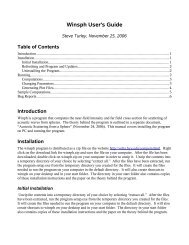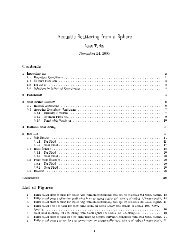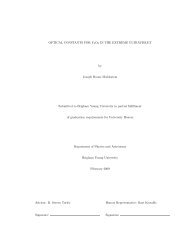Comparison of Cleaning Methods for Thin Film Surfaces
Comparison of Cleaning Methods for Thin Film Surfaces
Comparison of Cleaning Methods for Thin Film Surfaces
- No tags were found...
Create successful ePaper yourself
Turn your PDF publications into a flip-book with our unique Google optimized e-Paper software.
The Problem Organic contaminants collect on thesurface (Junk).– Interferes with measuring opticalconstants Example with visible light
Question:OutlineHow do we effectively remove contaminants?1. Measurementmethods2. <strong>Cleaning</strong> methods-Opticlean®-Plasma Etch-UV lamp3. Conclusions
Video Measurement method– Ellipsometry <strong>Cleaning</strong> methods tested– Opticlean– UV Lamp– Plasma Etch
Short Exposure Contamination Experiment (10 sec)450Additional Thickness (Ǻ)4003503002502001501005045014318 1601Spit onTouched with bare fingers (10s)Dipped in Deionized WaterTouched and rubbed with latex glove (10s)
Opticlean ® Process leaveshydrocarbon residue• Opticlean ® significantlyremoves contaminants,but leaves a residue• Ellipsometric ResultsOpticlean ® residuethickness on two runs:1) 17 Ångstroms2) 22 Ångstromshttp://www.dantronix.com• Opticlean ® made by Dantronix Researchand Technologies, LLC• Ellipsometer Type: J.A. Woollam Co., IncMulti-Wavelength Ellipsometer (EC110)http://www.jawoollam.com/
Scanning ElectronMicroscope showed no thinfilm damage, nor trace <strong>of</strong>materials used in thin filmson pulled <strong>of</strong> Opticlean ®films (U, Sc, Va).Does the Opticlean ®process damagethin films?X-Ray PhotoelectronSpectroscopy found notrace <strong>of</strong> materials used inthin films on pulled <strong>of</strong>Opticlean ® .
XPS revealed components <strong>of</strong> Opticlean ® ,but not heavier metals used in thin films.Prominent thin-film lines: U-380 eV, V-515 eV, Sc-400 eV684 eV (F 1s)527 eV (O 1s)281 eV (C 1s)Photons (Counts)97 eV (Si 2p)148 eV (Si 2s)Photon Energy (eV)
<strong>Cleaning</strong> residue with “Matrix”Plasma Etch RF Plasma Etching withO 2 Plasma– 0.120 Torr Pressure– 250W RF (max 350)– 0.75 SCCM O 2 flow– No extra heat applied Good <strong>for</strong> removingpolymers, but not bulkcontaminants (i.e. Dust) Oxygen plasma plusmechanical sputteringremoves surface layersRF
Plasma ResultsMatrix SystemChange in thickness (Å)20-2-4-6-8-10-120 2 4 6 8 10 12 14 16 18Minutes In Plasma
UV Lamp
ConclusionMethodEffectiveness<strong>Cleaning</strong> TimeEase <strong>of</strong> UseNotesOpticlean®Left residueMust wait <strong>for</strong>polymer to cureCan be difficult topeel <strong>of</strong>f.Good <strong>for</strong> dustetc..Oxygen PlasmaEffective. Cl notcompletely removedSetup takes a fewminutes. Cleanunder a minuteEquipment in cleanroom. Complex tosetup.Builds upsilicondioxideEximer UV LampEffective1 to 5 minutesVery easyLess silicondioxidebuildup thenplasma.Opticlean ® +Oxygen PlasmaEffective Possible 1Å residue or oxideLong, plasmasetup and polymercure time.Complex cleanroom equipmentand skill needed topeel Recommended Procedure:– UV lamp <strong>for</strong> 5 minutes





